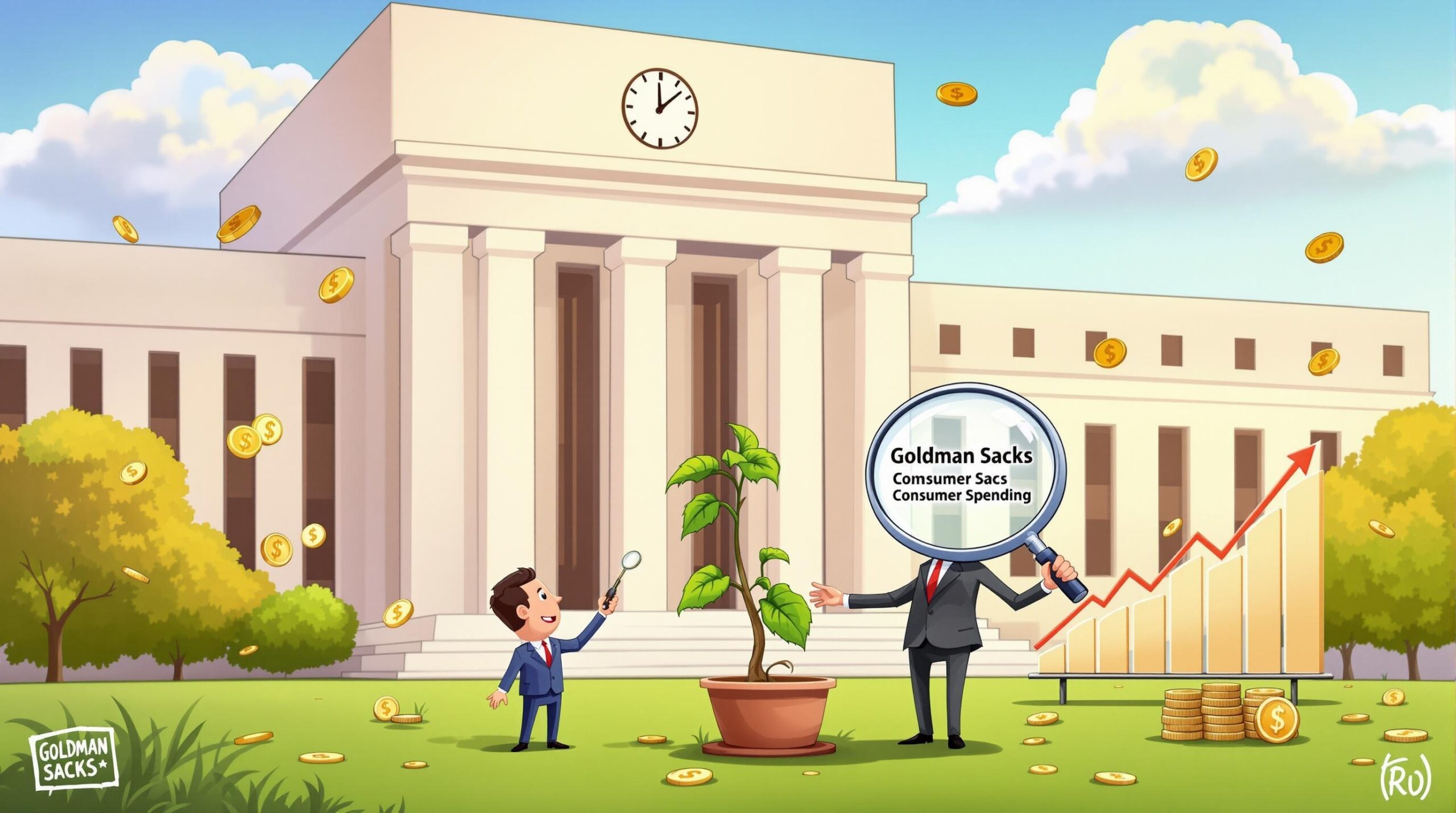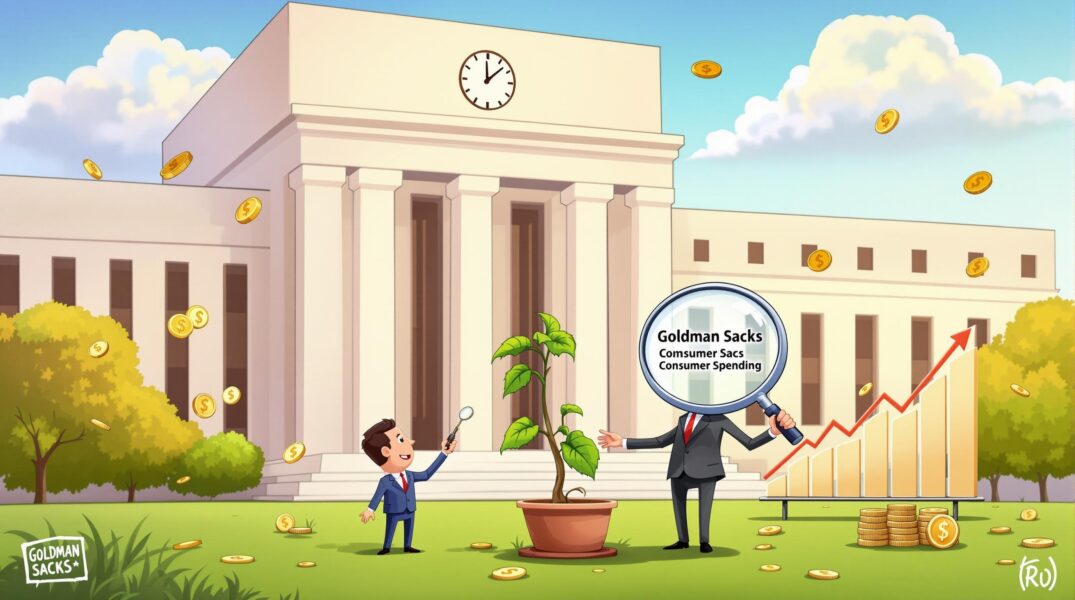BitcoinWorld

Fed Rate Cuts: Goldman Sachs Predicts Crucial Shift After July Hold
In the dynamic world of global finance, every whisper from major institutions can send ripples across markets, and for those tracking the pulse of the economy, few voices resonate as strongly as Goldman Sachs. Recently, a significant forecast has emerged that could profoundly impact everything from your mortgage rates to your crypto portfolio: Goldman Sachs is now predicting a series of Fed rate cuts starting later this year, following an anticipated hold in July. This isn’t just a minor adjustment; it signals a potentially crucial shift in monetary policy, driven by evolving economic realities.
Why Are Fed Rate Cuts on Goldman Sachs’ Radar?
According to insights shared by Walter Bloomberg on X, Goldman Sachs anticipates the U.S. Federal Reserve will maintain its current interest rates after its upcoming meeting. However, their outlook quickly pivots to a more dovish stance, projecting three subsequent rate reductions before the end of the year, followed by two more in early 2026. This aggressive forecast is rooted in two primary economic indicators:
- A Weakening Job Market: The once red-hot labor market, a bastion of strength for the U.S. economy, appears to be showing signs of cooling. A softening job market typically means fewer new hires, potentially rising unemployment, and slower wage growth. For the Fed, a looser labor market can signal that inflationary pressures from wages are easing, creating room to lower rates without reigniting price surges.
- Stagnant Consumer Spending: Consumer spending is the lifeblood of the American economy, accounting for a significant portion of GDP. If consumers are pulling back, perhaps due to inflation fatigue, higher borrowing costs, or economic uncertainty, it can signal a slowdown. Goldman Sachs’s assessment suggests that household budgets are feeling the pinch, leading to a deceleration in purchasing activity.
These two factors combined paint a picture of an economy that might be slowing more rapidly than previously assumed, compelling the Fed to consider a pivot from its hawkish stance of fighting inflation to a more accommodative one aimed at stimulating growth.
Understanding the Mechanics: How Do Fed Rate Cuts Work?
When the Federal Reserve decides to cut interest rates, it typically lowers the federal funds rate, which is the target rate for overnight lending between banks. This seemingly small adjustment has a cascading effect throughout the financial system:
- Lower Borrowing Costs: Banks can borrow money more cheaply, which, in turn, allows them to offer lower interest rates on loans to consumers and businesses. This includes mortgages, auto loans, credit card rates, and business lines of credit.
- Stimulating Investment: Cheaper borrowing encourages businesses to invest in expansion, new equipment, and hiring, as the cost of financing these ventures decreases.
- Boosting Consumer Spending: Lower interest rates can make big-ticket purchases more affordable (e.g., houses, cars), and can free up disposable income for consumers who have variable-rate loans.
- Impact on Savings: Conversely, lower rates typically mean lower returns on savings accounts, certificates of deposit (CDs), and other interest-bearing investments.
- Currency Impact: Lower interest rates can make a country’s currency less attractive to foreign investors, potentially leading to its depreciation.
Essentially, rate cuts are the Fed’s primary tool to inject liquidity and stimulate economic activity when it perceives a slowdown or recessionary risks.
The Ripple Effect: What Do Anticipated Fed Rate Cuts Mean for You?
The prospect of significant Fed rate cuts carries implications for various aspects of your financial life and investment strategies:
For Homeowners and Buyers: Will Mortgages Get Cheaper?
One of the most immediate and tangible impacts of Fed rate cuts is on the housing market. Lower federal funds rates generally translate to lower mortgage rates. For prospective homebuyers, this could mean increased affordability and a boost in purchasing power. Existing homeowners with adjustable-rate mortgages (ARMs) might see their monthly payments decrease. However, it’s important to remember that mortgage rates don’t move in lockstep with the federal funds rate, as they are also influenced by bond yields and market sentiment.
For Savers: A Diminished Return?
While borrowers rejoice, savers might face a less favorable environment. If the Fed cuts rates, banks typically follow suit by lowering the interest rates they offer on savings accounts, money market accounts, and CDs. This means your parked cash will earn less, potentially eroding its purchasing power over time, especially if inflation remains elevated.
For Stock Market Investors: A Potential Tailwind?
Historically, rate cuts are often seen as a positive for the stock market. Lower borrowing costs can boost corporate profits, and a stimulated economy generally leads to higher consumer demand. Companies find it cheaper to expand, innovate, and return capital to shareholders. Sectors like technology and growth stocks, which often rely on future earnings potential, can be particularly sensitive to interest rate changes. However, it’s crucial to note that the initial reason for cuts (a weakening economy) could cause some short-term volatility.
For Cryptocurrency Holders: A New Narrative?
The cryptocurrency market, while often seen as a distinct asset class, is not immune to macroeconomic forces. Lower interest rates can make traditional fixed-income investments less attractive, potentially pushing investors towards higher-risk, higher-reward assets like cryptocurrencies. Furthermore, a depreciating U.S. dollar (a potential consequence of rate cuts) could enhance the appeal of decentralized digital assets as alternative stores of value. Bitcoin, in particular, has sometimes been viewed as a ‘digital gold’ that benefits from inflationary or loose monetary policies. The narrative around crypto as an inflation hedge or a growth asset could strengthen with significant Fed rate cuts.
Challenges and Uncertainties on the Path to Fed Rate Cuts
While Goldman Sachs has laid out a clear projection, the economic landscape is rarely straightforward. Several factors could challenge this outlook:
- Persistent Inflation: Despite recent cooling, inflation could prove stickier than anticipated, forcing the Fed to maintain higher rates for longer to avoid a resurgence of price pressures.
- Geopolitical Shocks: Unforeseen global events, such as conflicts or supply chain disruptions, could introduce new inflationary pressures or economic instability, altering the Fed’s calculus.
- Data Dependency: The Fed has repeatedly emphasized its data-dependent approach. Any unexpected strength in the job market or a rebound in consumer spending could lead them to reconsider or delay rate cuts.
- Market Expectations vs. Reality: Sometimes, market participants price in rate cuts too aggressively, and if the Fed doesn’t deliver, it can lead to disappointment and volatility.
These uncertainties highlight the complex tightrope the Federal Reserve walks, balancing the need to control inflation with the imperative to support economic growth.
Actionable Insights for Navigating the Era of Potential Fed Rate Cuts
Given Goldman Sachs’s bold forecast, what steps can individuals and investors consider?
- Review Your Debt: If you have variable-rate debt (like certain credit cards or ARMs), now might be a good time to assess how lower rates could impact your payments. Consider refinancing fixed-rate debt if rates drop significantly.
- Re-evaluate Savings Strategies: With potentially lower returns on traditional savings, explore alternative avenues for growth, while maintaining an emergency fund in easily accessible accounts.
- Diversify Your Portfolio: A changing interest rate environment can favor different asset classes. Ensure your investment portfolio is diversified across various sectors and asset types, including potentially considering an allocation to digital assets if it aligns with your risk tolerance.
- Stay Informed: The Fed’s decisions are highly data-driven. Keep an eye on key economic indicators like inflation reports, employment figures, and consumer confidence surveys.
The key is to remain agile and adapt your financial strategy to the evolving economic landscape.
Conclusion: A Pivotal Moment for Monetary Policy
Goldman Sachs’s projection of multiple Fed rate cuts beginning later this year marks a significant turning point in the economic narrative. Driven by a weakening job market and stagnant consumer spending, this shift could bring relief to borrowers, stimulate investment, and potentially reshape the outlook for various asset classes, including the burgeoning cryptocurrency market. While uncertainties remain, understanding these potential shifts is crucial for making informed financial decisions in the months ahead. The Fed’s next moves will undoubtedly be among the most watched events in global finance, and their impact will resonate far beyond Wall Street.
Frequently Asked Questions (FAQs) About Fed Rate Cuts
Q1: What exactly does Goldman Sachs predict regarding Fed rate cuts?
Goldman Sachs expects the U.S. Federal Reserve to keep rates unchanged in July, then initiate three rate cuts in the latter half of this year, followed by two more cuts in early 2026. This forecast is based on observations of a weakening job market and stagnant consumer spending.
Q2: How do Fed rate cuts typically affect the average consumer?
For the average consumer, Fed rate cuts can lead to lower interest rates on various loans, including mortgages, auto loans, and credit cards, making borrowing cheaper. However, they also typically result in lower returns on savings accounts and certificates of deposit (CDs).
Q3: What impact could these predicted Fed rate cuts have on the cryptocurrency market?
Lower interest rates can make traditional investments less attractive, potentially encouraging investors to seek higher returns in riskier assets like cryptocurrencies. A weaker U.S. dollar, which can result from rate cuts, might also enhance the appeal of decentralized digital assets as alternative stores of value, potentially boosting crypto prices.
Q4: What are the main reasons the Fed might decide to cut rates?
The primary reasons the Federal Reserve typically considers cutting rates include signs of a slowing economy, such as a weakening job market, declining consumer spending, or a significant drop in inflation, all aimed at stimulating economic growth and preventing a recession.
Q5: Are Goldman Sachs’s predictions guaranteed to happen?
No, Goldman Sachs’s predictions are forecasts based on current economic data and their analytical models. The Federal Reserve’s decisions are data-dependent and can change based on evolving economic conditions, inflation trends, and unforeseen global events. Their outlook serves as a significant market expectation, but not a certainty.
If you found this analysis insightful, please share it with your network! Help us spread awareness about these crucial economic developments and their potential impact on personal finance and investment strategies.
To learn more about the latest crypto market trends, explore our article on key developments shaping Bitcoin institutional adoption.
This post Fed Rate Cuts: Goldman Sachs Predicts Crucial Shift After July Hold first appeared on BitcoinWorld and is written by Editorial Team





